
Andrzej Tadeusz Bonawentura Kościuszko was a Polish military engineer, statesman, and military leader who then became a national hero in Poland, the United States, Lithuania and Belarus. He fought in the Polish–Lithuanian Commonwealth's struggles against Russia and Prussia, and on the U.S. side in the American Revolutionary War. As Supreme Commander of the Polish National Armed Forces, he led the 1794 Kościuszko Uprising.
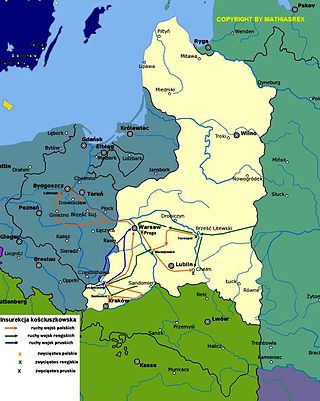
The Kościuszko Uprising, also known as the Polish Uprising of 1794, Second Polish War, Polish Campaign of 1794, and the Polish Revolution of 1794, was an uprising against the Russian and Prussian influence on Polish–Lithuanian Commonwealth, led by Tadeusz Kościuszko in Poland-Lithuania and the Prussian partition in 1794. It was a failed attempt to liberate the Polish–Lithuanian Commonwealth from external influence after the Second Partition of Poland (1793) and the creation of the Targowica Confederation.

Logan Square is an official community area, historical neighborhood, and public square on the northwest side of the City of Chicago. The Logan Square community area is one of the 77 city-designated community areas established for planning purposes. The Logan Square neighborhood, located within the Logan Square community area, is centered on the public square that serves as its namesake, located at the three-way intersection of Milwaukee Avenue, Logan Boulevard and Kedzie Boulevard.
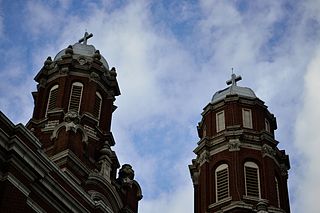
Avondale is one of Chicago's 77 officially designated community areas. It is on the Northwest Side of the city. The northern border is Addison Street from the north branch of the Chicago River in the east to Pulaski Road in the west. The neighborhood extends further west along Belmont Avenue to the Union Pacific/Northwest Line. Its southern border is Diversey Avenue from the Union Pacific/Northwest Line to the Chicago River.

Kraków Old Town is the historic central district of Kraków, Poland. It is one of the most famous old districts in Poland today and was the centre of Poland's political life from 1038 until King Sigismund III Vasa relocated his court to Warsaw in 1596.

Thaddeus Kosciuszko National Memorial preserves the home of Tadeusz (Thaddeus) Kościuszko at 301 Pine Street in Philadelphia, Pennsylvania. The life and work of the Polish patriot and hero of the American Revolution are commemorated here.

The Church of the Immaculate Conception, referred to in Polish as Kościół Niepokalanego Poczęcia Najświętszej Maryi Panny, is a historic church of the Roman Catholic Archdiocese of Chicago located at 2944 East 88th Street in Chicago, Illinois. It is a prime example of the so-called 'Polish Cathedral style' of churches in both its opulence and grand scale. Along with St. Michael's, it is one of the two monumental Polish churches dominating the South Chicago skyline.

Kościuszko Mound is an artificial mound in Kraków, Poland. It was erected by Cracovians in commemoration of the Polish national leader Tadeusz Kościuszko, and modelled after Kraków's prehistoric mounds of Krak and Wanda. A serpentine path leads to the top, approximately 326 metres (1,070 ft) above sea level, with a panoramic view of the Vistula River and the city.
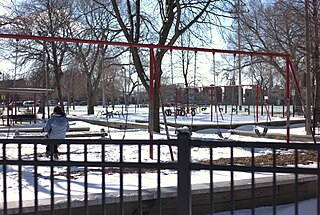
Chopin Park is an 8-acre (32,000 m2) park located at 3420 North Long in the Portage Park community area of North Side, Chicago, Illinois.
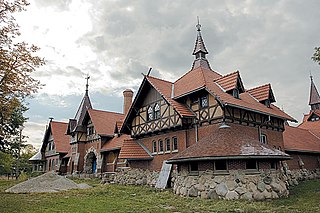
Humboldt Park is a 207-acre (84 ha) park located at 1400 North Sacramento Avenue in West Town, on the West Side of Chicago, Illinois. It opened in 1877, and is one of the largest parks on the West Side. The park's designers include William Le Baron Jenney, and Jens Jensen.

Królikarnia is a historic classicist palace in Warsaw, Poland; and a neighborhood in the Mokotów district of Warsaw.
Lincoln Village is a south side neighborhood within the City of Milwaukee.

Indian Boundary Park is a 13-acre (5.3 ha) urban park in the West Ridge neighborhood of North Side, Chicago, Illinois.

Austin Town Hall Park is a park at 5610 W. Lake Street in the Austin neighborhood of Chicago, Illinois. The site was formerly used for the town hall of Cicero Township. The Austin subdivision of Cicero was annexed to the City of Chicago in 1899, and the town hall site eventually became part of the Chicago Park District. The park's fieldhouse, designed by Michaelsen and Rognstad in the 1920s, is influenced largely by Philadelphia's Independence Hall.

Brigadier General Thaddeus Kościuszko is a bronze statue honoring Polish military figure and engineer Tadeusz Kościuszko. The sculpture was dedicated in 1910, the third of four statues in Lafayette Square, Washington, D.C., to honor foreign-born heroes of the American Revolutionary War. Born in the Polish–Lithuanian Commonwealth in 1746, Kościuszko later received education at a Jesuit school before attending the Corps of Cadets in Warsaw. He later traveled to France where he studied in military academy libraries and adopted views of human liberty during the Age of Enlightenment. He moved to the Thirteen Colonies in 1776, where the war with the Kingdom of Great Britain had already begun. Kościuszko served as an engineer in the Continental Army, earning the praise of his superiors, including General George Washington.
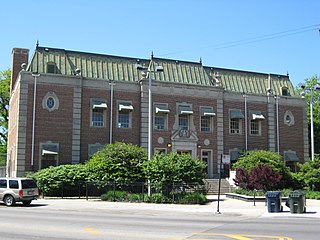
Riis Park is a 56-acre park on Chicago's Northwest Side in the Belmont-Cragin neighborhood. The park is named for Jacob Riis, a famous New York City muckraker journalist and photographer who documented the plight of the poor and working class. Riis was designed to include a variety of recreational amenities for the middle class community that it served. It was developed in 1928 when a ski jump and golf course was installed. Chicago Architect Walter W. Ahlschlager designed the fieldhouse.

Tadeusz Kościuszko is one of the most honored persons in Polish history, in terms of places and events named in his honor.

The Shedd Park Fieldhouse is the historic fieldhouse in Shedd Park, a public park in the South Lawndale community area of Chicago, Illinois. John G. Shedd, for whom the park and fieldhouse are named, gave the city the land for the park. The Prairie School building was designed by William Drummond and built in 1917. The brown brick building features limestone trim. A Prairie School gymnasium designed by Michaelsen and Rognstad was added to the building in 1928.

The National Museum of Puerto Rican Arts and Culture is a museum in Chicago dedicated to interpreting the arts and culture of the Puerto Rican people and of the Puerto Ricans in Chicago. Founded in 2001, it is housed in the historic landmark Humboldt Park stables and receptory, near the Paseo Boricua.

Hamilton Park is a public park at 513 W. 72nd Street in the Englewood neighborhood of Chicago, Illinois. The park opened in 1904 as part of a plan led by the South Park Commission to add small neighborhood parks on Chicago's South Side. It was the first public park in Englewood. Landscape designers the Olmsted Brothers and architecture firm D. H. Burnham & Company collaborated on the park's design. The park opened with a fieldhouse, baseball field, wading pool, and walkways; within the decade, the designers added gymnasiums, a playground, and tennis courts. The fieldhouse has a Beaux-Arts design, and its inside features several murals of prominent figures in American history. The park was heavily used after it opened, and the fieldhouse in particular was booked so consistently that it was expanded in the 1920s.





















